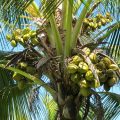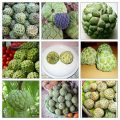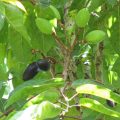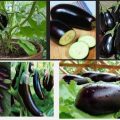In the Philippines, cashew is called kasoy or balubad in Tagalog or Balogo in Ilokano. It originated from north-eastern Brazil and was brought to the Philippines in the 17th Century. At present, cashew is cultivated in many tropical countries, the main producers are Brazil, India, Mozambique and Tanzania.

The cashew plant is an evergreen tree that grows up to 12 meters tall, with a dome-shaped crown or canopy bearing its foliage on the outside, where flowers and fruits are found.
The growth of the taproot reaches a depth of 1.5-2 times the height of the plant during the first 4 months. Extensive lateral roots are formed later and reach far beyond the canopy spread of the tree during the first year of growth. In mature trees, the root volume is generally confined within the tree canopy. Very few laterals are formed beyond the 6 meter drip-line of the tree.
The fruit has a kidney-shaped nut, about 3 cm x 1.2 cm attached to a much enlarged and swollen pedicel or receptacle forming the fruit-like cashew apple. The cashew apple is pear-shaped, 10-20 cm x 4-8 cm, shiny, red to yellow, soft, and juicy. The seed is kidney-shaped, with reddish-brown testa, two large white cotyledons, and a small embryo. The kernel remaining after the removal of the testa is the cashew nut of commerce.
Favorable Growing Conditions
It can grow successfully in areas with a very distinct dry season or where the annual rainfall is as low as 50 cm. It can likewise grow well in areas with high levels of rainfall (as much as 350 cm annually) provided the soil is well-drained.
Seed System
1. Nursery Site
The nursery site should be well-drained and exposed to sunlight. It should have a good source of irrigation water for the maintenance of the plant materials. It should be protected against stray animals.
2. Nut Selection
Nuts for planting should be obtained from mother trees of known performance. They should be fully matured and of high density (heavy) grade to ensure good germination and vigorous seedlings. Seeds are water tested; those that sink are chosen since they have higher viability and germinate quickly.
3. Sowing the Seeds
Cashew seeds expire easily. Dry and newly collected seeds must be sown/propagated as soon as possible to prevent loss in viability. They are sown on individual polyethylene bags containing an equal mixture of fine sand and organic matter.
Seeds are sown 5-10 cm deep with stalk end facing upward in slanting position. This prevents the emerging cotyledons at the soil surface from being destroyed by rats, ants, snails, and birds.
4. Care of Seedlings
Seeds will germinate within 1 to 2 weeks after sowing. Excessive watering should be avoided. If seedlings are week and stunted, urea solution at the rate of 10 tbsp per gallon of water should be applied.
The seedlings must be properly taken care of until they are ready for field planting or for use in asexual propagation (grafting). Seedlings are ready for field planting when they have attained a height of 20-50 cm.
5. Propagation
Cashew can be propagated sexually or asexually. Asexual propagation can be done through airlayering, inarching, marcotting or grafting. Grafting is the best method for large-scale asexual propagation of cashew.
With cleft grafting, the seedlings are cut in traverse section (crosswise) and the remaining stem is cut longitudinally (lengthwise). The scion from a selected mother tree cut into the shape of a wedge is put between the two separated parts of the stem of the seedling, and the seedling and the scion are then wrapped with a plastic ribbon.
Up to 100% success has been obtained with 10-week old seedlings. In Palawan, plant propagators can get an average of 95% success in cleft grafting.
The use of young seedlings of about two months old result in more rapid takes, and the plants are ready to be planted at the age of 3 ½ months.
Sexual propagation is done by sowing the seeds directly on individual polyethylene bags. It should be done during the dry season so that the seedlings could be planted in the field at the start of the rainy season.
Land Preparation
For commercial purposes, the land should be thoroughly prepared. Plow the area 2-3 times followed by harrowing until the desired tilth of the soil is attained. It should be done before the start of the rainy season. For backyard or reforestation purposes, just underbrush the area and if possible collect all cut grasses, shrubs, and other rubbishes and burn them. The soil should be cultivated properly in order that the seeds may be sown with the required depth or that holes may be dug deep enough to bury the ball of seedlings. Rows of cashew trees should be properly laid out with the proper distancing by placing markers at the desired distance between hills in a row before digging the holes.
Crop Establishment
1. Distance of planting
Distance of planting varies according to the purpose for which the trees are planted. For reforestation, 3m x 3m is recommended to encourage early shading and to aid in smothering weeds.
For commercial plantings in the Philippines use 6m x 6m which is too close compared to the practice in other countries.
Triangular planting was found to be most productive layout and should be tried. This method, however, is rather difficult for farmers to follow.
High density planting gives more kernel per hectare up to age 7 years. Low density planting gives less per hectare but more per tree.
a. Triangular (12m x 12m x 12m) = 79 plants/ha
An alternative and easier method is the quincunx arrangement and should also be tried.
b. Quincunx (15m x 15m) = 76 plants/ha
c. Square
The simplest recommended planting distances are 9m x 9m at the less fertile lower slopes and 10m x 10m at the more fertile lower slopes.
2. Lining, Stacking and Digging of Holes
Rows of cashew should be properly laid out by placing markers between rows and between hills in a row.
The holes should be dug a month before the planting of seedlings. The holes should have a dimension 20 cm x 20 cm.
3. Planting Time
In places with distinct dry and wet seasons, planting is best done at the start of the rainy season.
4. Planting
There are two methods of establishing cashew that may be employed. These are direct seeding and transplanting of seedlings or sexually propagated materials.
In direct seedlings, 2 to 3 seeds are planted 5-10 cm deep with the stalk end facing upward and in a slanting position. This prevents emerging cotyledons at the soil surface from the ravages of field rats, ants, snails and birds.
Seeds are planted 30 cm apart in a triangular position when 3 seeds are used. The seeds will germinate 1-2 weeks after sowing provided that the soil has sufficient moisture.
Thinning should be done leaving only the most vigorous plant to develop 1-2 months from germination. Thinning is preferably done during the start of the rainy season.
When transplanting seedlings or sexually propagated materials, remove carefully the polyethylene plastic before setting the seedlings in the holes.
Fill the holes with surface soil first and firm the soil at the base of the seedling carefully allowing the roots to remain in as natural as possible.
5. Weeding and Cultivation
The plants should be cultivated and free from weeds at a distance of 1 meter around the trunk. The orchard should be weeded as often as necessary. Cut grasses should be left in the area between the hills to dry and to used later for mulching. Mulching helps conserve moisture around the plant during the summer months, keep down the weeds and increase the amount of humus in the soil when decays.
6. Intercropping and Covercropping
A considerable part of the land is available for intercropping during the early years after the establishment of the cashew orchard.
To provide sufficient protection from the heavy growth of weeds and grass, the spaces between rows may be used for planting cash crops. This would enable the grower to earn additional income.
Annual crops can be interplanted between rows of cashew provided they are not closer than 2 meter from the cashew tree.
When the growing of intercrops is no longer feasible, the field should be planted to leguminous covercrops. The planting of covercrops will prevent further soil erosion, conserve moisture, and add organic matter to the soil. The area within 1 to 1 1/2 meters from the trunk should be kept free from weeds and covercrops should not be allowed to cling to the tree.
7. Pruning
Little pruning is practiced in cashew. However, it may be necessary to prune regularly to get the desirable shape of the tree and to facilitate cultural operations.
It is also necessary to remove the diseased and infected branches and unnecessary water sprouts.
It is also necessary to remove the diseased and infected branches and unnecessary water sprouts.
8. Cut wounds should be properly treated with chemicals (coaltar) to facilitate healing and avoid infections.
Nutrient Management
It is advisable to apply fertilizers especially when soil analysis dictates specific soil nutrient deficiencies.
The general recommendations are the following:
Seedlings – At planting time apply complete fertilizer (14-14-14) before the seedlings are set in the holes at the rate of 200-300 gm/plant.
Young Trees – Apply complete fertilizer at the rate of 300-500 gm/tree plus Urea (45-0-0) at the rate of 200-300 gm/tree.
Bearing Trees – Apply complete fertilizer (14-14-14) at the rate of 1.5 to 3.0 kg/tree.
Recommended rate of fertilizer application is applied two times a year. One half of the total requirement per tree should be applied at the start of the rainy season and the remaining half should be applied toward the end of the rainy season.
On established trees, fertilizer should be dug with a depth of 1-10 cm. The fertilizer is then distributed equally. Cover the holes/canal properly with soil to prevent the fertilizer from evaporating or from being washed out by heavy rains.
Water Management
Irrigation is needed during the first dry season. Unlike in the subsequent years, when the root system has already been established and have reached the layer with sufficient moisture. For better yield, it is advisable to irrigate the field regularly especially during summer.
Pest Management
Major Pests
Twig Borer (Niphonoclea albata N. /N. capito P.)
This insect pest are common during the dry season. The adult beetle girdles the small branches causing them to dry up or break and drop to the ground. Its creamish larvae bore into the pith of the branches. As they feed, they move downward until they pupate. All affected twigs and small branches may eventually die.
Control Measure: Remove or collect all affected twig as well as dried twigs on the ground. Dispose them properly by burning before applying chemical sprays. In using spray chemicals, mix 3-5 tbsp of Malathion, Carbaryl and/or Methyl Parathion per 5 gallons of water. Repeat application at 7-10 days interval when necessary.
Mealybugs (Gray Mealybugs – F. vigata) and Thrips (Red-banded thrips – Selen othrips rubrocintus Glard)
These pests sucks the sap of young leaves and shoots. When severe infestation occurs, the tree is weakened and the leaves and fruit may fall prematurely.
Control Measures: Spray trees with any insecticide commonly available at manufacturer’s recommended dosage when there are signs of early infestation.
Leaf Miner (Acrocercops syngramma M.) – Young plants in the nursery and in the orchard are more affected by these pests. Caterpillars of this silvery gray moth mine through the tender leaves, thus, severely damaging them.
Control Measures: Spray 0.05% Phosphamidon at manufacturer’s recommended dosage as soon as infestation is detected on new leaves.
Tea Mosquito (Helopeltis Antonil S.) – A reddish-brown mirid bug which normally appears at the time of emergence of new growth and panicles. Nymphs and adults suck the sap from tender nuts.
Control Measures: Spray Malathion, Phosphamidon and/or Endosulfan at emergence of new growth and inflorescence. A third spray may be done at the time of fruit setting to reduce immature fruit drops.
Saw-Toothed Grain Beetle (Cryzaephillus surinamensis L.) – This pest is known to attack the nuts during storage.
Control Measures: Nuts should be thoroughly dried and placed in air tight containers. Surface treatment is recommended. For finished products, fumigation is recommended.
Slug Caterpillar (Lamantridae spp.) – The caterpillar feeds on the leaves causing semi-defoliation.
Termite – Termites attack the roots and the trunk of cashew trees. They burrow on the bark of roots and branches especially of old trees. They build their soil mounds or nest on dead parts of the tree.
Control Measures: Soil mounds must be destroyed to locate the queen termite. The queen should be killed either mechanically or by spraying with 2% Chlordane. Chlordane should not be applied on living parts of the tree because of its long residual effect. Cistin powder could be applied to any part of the tree infested with termites at the rate recommended by the manufacturer.
Major Diseases
Dieback or Pink Disease – This disease is caused by fungus Corticium salmonicolor B. that usually occurs during the rainy season. Affected shoots initially show white patches on the bark; a film of silky thread or mycelium develops. Later, the fungus develops a pinkish growth which are the spores that make the bark split and peel off. Affected shoots start drying up from the tip.
Control Measures: All possible sources of innoculum should be removed. Affected shoots are pruned and burned. Cut surfaces must be protected by applying Bordeaux moisture paste. The tree should also be sprayed with fungicide at manufacturer’s recommended dosage.
Anthracnose – This disease is cause by fungus Collectorichum gloeospoides that usually infect tender leaves, shoots, inflourescences, young fruits (apples) and young nuts. This disease is most prevalent when there is excessive rainfall coinciding with the appearance of new growth and flowering. Infected parts in its early stage show shiny, watersoaked lesions which later turn reddish-brown. At the lesion site, resinous exudation can be seen. As the disease progresses, the lesions enlarge in size, all affected tender leaves wrinkle, and the young apples and nuts become shrivelled. Inflorescences become black.
Control Measures: Remove all infected parts (source of innoculum) before spraying the tree with fungicide at manufacturer’s recommended dosage of application.
Damping-off – This disease is caused by fungus Fusarium. This disease normally occurs in the nursery and effects cashew seedlings especially when the soil medium gets too wet.
Control Measures: Seeds for planting should be treated with Arasan 75 at the rate of ¼ tsp per ganta of seeds before sowing. Soil media for potting should be treated with soil fumingants.
Harvest Management
In the Philippines, cashew trees flower from November to March, while the harvest season is from February to May and may extend up to early June. The quality of nuts and yield is dependent on weather conditions during the fruiting stage. If it rains during the reproductive phase, poor quality nuts are produced. Fruits are usually harvested manually, although a number of farmers wait for the fruits to drop as the main concern of farmers is the nut. Nuts are picked from the ground, separated from the cashew apple, cleaned and dried.
In places where cashew apples are processed into juice, wine and other delicacies, fruits are harvested using a pole with a wire hook attached to its end. The pole is provided with a shallow net or cloth bag to catch the detached fruits.
Processing and Utilization
Nuts are roasted and eaten. At present, the only commercial scale use for the cashew apple is for livestock feed. However, the cashew apple is now being processed into juice, candy, wine, jam, etc. but only to a certain extent since the market for these end products is still in the development stage.
Sources of Cashew Planting materials
Palawan Seed Farm
Puerto Princesa City
Bureau of Plant Industry Nursery
Visayas Avenue, Quezon City
Guimaras Seed Farm
Jordan, Guimaras, Iloilo
Source: bar.gov.ph






